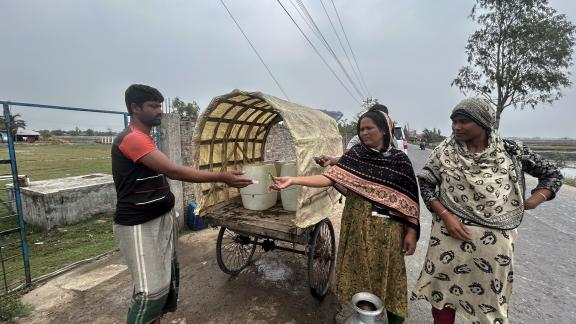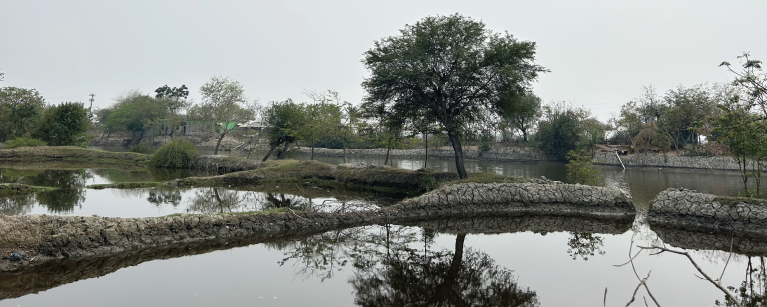“World Water Day was observed last month with the slogan ‘Water for Peace.’ But this ‘peace’ is disrupted everywhere. The climate is changing dramatically, and the crisis of fresh drinking water is increasing alongside. Many experts think the next war will be only for water.”
A 5-7 feet wide handmade dam separates the Chuna River from the pond. Amidst it, a Jarul tree guards the pond like a defeated commander, as if reminding us of the famous Bengali proverb, 'Tal Patar Sepai'.
Pointing to that tree, Bindubala (pseudonym) was trying to describe how the saline water from the Chuna River flooded all freshwater ponds, including this one, during Cyclone Aila in 2009. While speaking, she paused repeatedly, looking at the dry, raddled pond, much like her old pitcher. Her eyes wailed for fresh drinking water, representing thousands of people in the coastal region of Satkhira. Bindubala said with a somber voice, ‘We are living amid water, but not a single drop is drinkable.’ And we are yet too far from ensuring water rights for people like Bindubala.
World Water Day was observed last month with the slogan ‘Water for Peace.’ But this ‘peace’ is disrupted everywhere. The climate is changing dramatically, and the crisis of fresh drinking water is increasing alongside. Many experts think the next war will be only for water. We are already in the war zone of the water crisis, not only because of climate change but also due to a dispute over the water share of transboundary resources. As one of the most climate-affected countries in the world, Bangladesh's coastal region has been facing an extreme lack of fresh drinking water for years. Like Satkhira, thousands of ponds are full of saline water.
According to the United Nations, 73 percent of the people in five coastal upazilas in Satkhira are drinking saline water.
Bindubala lives in Atulia union of Shyamnagar, and her nearest freshwater pond is about a 15-minute walk away. This water can only be used for cooking and other household uses, not for drinking. She and her neighbors walk around 2 kilometers to the nearest water purifier to collect fresh drinking water, which means they invest 3-5 hours daily in collecting drinking water. This is the daily routine of the entire coastal region of Satkhira, especially in Shyamnagar, Kaliganj, Debhata, and Ashashuni areas.
The water crisis also contributes to economic and social imbalance. The financial cost of drinking water from community water purifiers has increased more than 5 times in the last 10 years. Each pitcher (kolos) costs 20-40 BDT and varies in different areas. Every month they spend thousands of takas on drinking water. Buying water at this high price heavily challenges them to invest in better living and education. The lack of drinking water disrupts their children’s education, increases internal migration, and even leads to gender discrimination and violence against women.
I had opportunities to hear from the impacted communities. I have learned that everyone is concerned about women's health issues associated with water. The increasing cost of buying drinking water also affects their healthy food intake (as the food price also increases), savings, education, and many more. On the other hand, women’s skin becomes darker due to the use of excessive saline water, which is not acceptable to their husbands. As a result, violence against women has increased and eventually resulted in divorce in many cases. Even this social stigma triggered by the use of excessive saline water also escalates the ratio of child marriage, as adolescent girls' skin is comparatively fairer in complexion.

People from the community are forced to buy purified drinking water.
Unable to cope with frequent natural hazards and freshwater scarcity, hundreds of families have migrated to Khulna, Dhaka, Barishal, and even India. The challenges are still increasing. Not every family can ensure a home-based rainwater harvesting system. Not everywhere has PSF (Pond Sand Filter) or RWH (rainwater harvesting system). During the monsoon, fresh water becomes more abundant, but in winter and summer, fresh water is so inadequate that their life becomes unimaginable. Along with the salinity, water pollution is another hardship for this region. The use of several poisonous fertilizers in fish, crab, and shrimp gher is a direct health threat, and the gher owners feel merely accountable for it. The ratio of agriculture in these areas is still secondary, hence, we are not putting the use of pesticides in this discussion.
Mentioning the water pollution, Oxfam’s recent report stated that only 28 percent of the world’s most influential food and agriculture corporations report they are reducing their water withdrawals and just 23 percent say they are taking action to reduce water pollution.
The scarcity of drinking water in this region is nothing new. But this crisis not only belongs to nature but also to community conflicts, lack of accountability, and coordination of local, national, and regional stakeholders. Adding to that blockage of river flow, filling of ponds, appropriation of channels, uncontrolled shrimp farming, and lack of high embankment around the shrimp gher, are putting more weight on this crisis. UN warned that in over 45 years, an estimated 2 billion people do not have safe drinking water, and up to 3 billion people experience water shortages for at least one month each year. Undoubtedly, people in this region are among them.
To overcome this problem, a coordinated approach of government, non-government organizations, and community people is a must. Close collaboration and integration of national and regional policymakers to have inclusive water management is needed. Note that, from Cyclone Sidr to Aila, almost every conventional technologist failed to solve the water crisis here. Pond water is the last hope, which needs to be properly maintained. Proper management of freshwater sources including ponds needs to be implemented to halt saltwater intrusion. To ensure sustainable solutions, solidarity and inclusion are a must. Government allocation must be needed to resolve this burning water crisis in the coastal region. More financial support from the Loss and Damage fund can be utilized here.
Lastly, water should be recognized as a human right and a public good. Only then will water bring “Peace”.
The writer can be reached at MShislam@oxfam.org.uk
